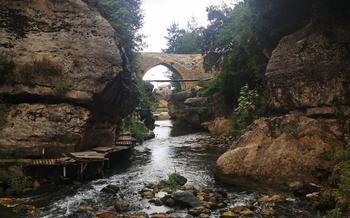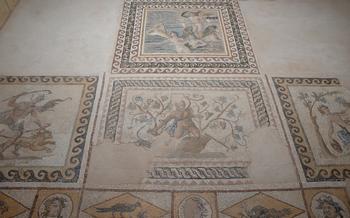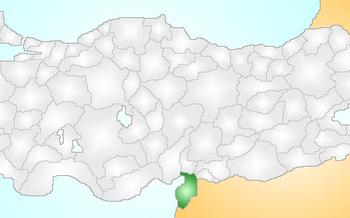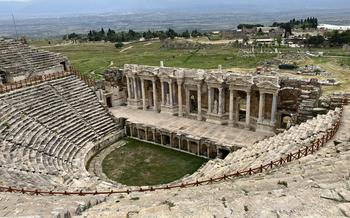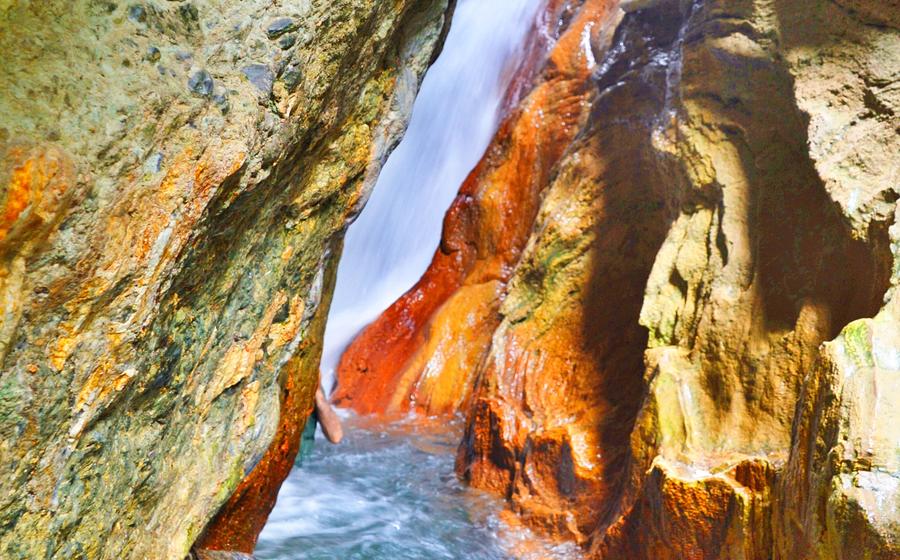
Hain der Daphne
- Location and Transportation
- Admission Fees and Opening Hours
- Hain der Daphne: A Symbol of Love and Loss
- Exploring the Site's Architectural Remains
- Mosaics: A Glimpse into Ancient Life
- The Natural Beauty of the Surroundings
- Hain der Daphne Museum
- Guided Tours and Local Guides
- Photography and Social Media
- Nearby Attractions and Itineraries
- Local Cuisine and Dining Options
- Accommodation Options for Visitors
- Insider Tip: Explore the Site at Sunrise or Sunset
Location and Transportation
The Hain der Daphne is situated in the Samandağ district of Hatay province, Turkey. It is located approximately 25 kilometers from the city center of Antakya, the capital of Hatay. The site is easily accessible by public transportation, with regular buses departing from Antakya to Samandağ. The journey takes about 45 minutes to an hour.
For those traveling by car, the Hain der Daphne is well-connected by a network of roads. From Antakya, take the D825 highway towards Samandağ. After passing through the town of Dörtyol, look for signs for the Hain der Daphne, which will be on your left. The drive from Antakya to the site takes about 30 minutes.
The site is well-maintained and offers ample parking for visitors. Once you arrive, you can explore the ruins and surrounding area on foot or take a guided tour.
Admission Fees and Opening Hours
Visiting the Hain der Daphne is an affordable experience, with entrance fees set at a reasonable rate for both domestic and international tourists. Discounted rates or free entry may be available for students, senior citizens, or groups. The site's operating hours during the week are generally consistent, allowing visitors to plan their visit accordingly. However, it's important to note that seasonal variations in opening hours may occur, especially during peak tourist seasons or public holidays. To avoid any inconvenience, it's advisable to check the official website or contact local tourism authorities for the most up-to-date information on admission fees and opening hours.
Hain der Daphne: A Symbol of Love and Loss
The ancient Greek myth of Daphne and Apollo adds a poignant layer of symbolism to the Hain der Daphne.
Exploring the Site's Architectural Remains
Amidst the serene natural setting, the architectural remnants of the Hain der Daphne stand as poignant reminders of its glorious past. While time and natural forces have eroded much of the original structures, the surviving elements offer valuable insights into the site's former grandeur and architectural prowess.
The most prominent feature of the site is the Nymphaeum, a monumental fountain adorned with intricate carvings and sculptures. Once a source of water and a symbol of abundance, the Nymphaeum now stands as a testament to the site's architectural mastery. Its elaborate design and skillful execution highlight the craftsmanship and artistry that went into its creation.
Other notable remains include the Temple of Apollo, where the deity was once worshipped, and the surrounding colonnades that provided shelter and shade to visitors. These structures, though partially ruined, still evoke a sense of awe and reverence, hinting at the religious and cultural significance that this site once held.
Scattered throughout the grounds are fragments of columns, capitals, and architraves, each bearing witness to the intricate and harmonious architectural style that characterized the Hain der Daphne. These remnants serve as a tangible connection to the past, inviting visitors to piece together the history and splendor of this ancient sanctuary.
Mosaics: A Glimpse into Ancient Life
Amidst the ruins of Hain der Daphne, visitors can discover a collection of exquisite mosaics that have withstood the test of time. These intricate artworks, meticulously crafted from colorful tiles, offer a window into the lives of the ancient inhabitants of this sacred site.
The mosaics depict a variety of subjects, including scenes from mythology, daily life, and religious rituals. One particularly striking mosaic portrays a procession of priests carrying offerings to the temple. The vivid colors and intricate details bring the scene to life, allowing visitors to imagine the grandeur and solemnity of these ancient ceremonies.
Another mosaic depicts a hunting scene, with a group of hunters pursuing a wild boar through a lush forest. The animals are depicted with remarkable realism, capturing their movements and expressions with astonishing accuracy. The mosaic provides a glimpse into the hunting practices of the ancient Greeks and Romans, who relied on these skills to obtain food and other resources.
The mosaics at Hain der Daphne are not only beautiful works of art but also invaluable historical documents. They provide archaeologists and historians with insights into the culture, beliefs, and daily lives of the people who once inhabited this sacred site. Each mosaic tells a story, offering a glimpse into the rich tapestry of ancient life.
The Natural Beauty of the Surroundings
The Hain der Daphne is nestled amidst a breathtaking natural landscape that complements the site's historical significance. Surrounded by lush greenery, gently flowing streams, and towering mountains, the site exudes an air of serenity and tranquility. The surrounding environment plays a crucial role in enhancing the visitor's experience, creating a harmonious blend of history, nature, and culture.
The natural beauty of the site is not merely a backdrop but an integral part of the Hain der Daphne's allure. The verdant landscape provides a picturesque setting, inviting visitors to explore the ruins while immersing themselves in the tranquility of nature. The gentle rustling of leaves in the breeze, the melodious chirping of birds, and the soft murmur of water create a symphony of sounds that transport visitors to another era.
The site's integration with its surroundings is a testament to the ancient builders' understanding of harmony and balance. The structures were carefully positioned to take advantage of the natural landscape, creating a seamless connection between the built environment and the natural world. This integration enhances the visitor's experience, allowing them to appreciate the site not only for its historical significance but also for its natural beauty.
The landscape surrounding the Hain der Daphne is not just visually appealing but also holds historical and cultural significance. The mountains that form the backdrop of the site were once home to ancient civilizations, and their presence adds a layer of depth and intrigue to the site. The streams and rivers that flow through the area have been a source of water and sustenance for centuries, shaping the lives of the people who inhabited this region.
Exploring the Hain der Daphne is not just a journey through history but also a journey through nature. The site's natural surroundings invite visitors to slow down, appreciate the beauty of the landscape, and connect with the environment in a meaningful way. Whether it's taking a leisurely walk along the stream, enjoying a picnic in the shade of trees, or simply sitting in contemplation amidst the ruins, the natural beauty of the Hain der Daphne offers a unique and unforgettable experience.
Hain der Daphne Museum
Within walking distance from the ancient site, the Hain der Daphne Museum offers a captivating glimpse into the history and significance of the Hain der Daphne. This modern, well-curated museum houses a collection of artifacts unearthed during excavations at the site. These artifacts include intricate mosaics, sculptures, pottery, and coins.
The museum's displays are designed to provide visitors with a comprehensive understanding of the site's history, from its origins in ancient Greek mythology to its transformation into a Roman sanctuary. Visitors can learn about the lives and beliefs of the people who inhabited the site, as well as the cultural and artistic influences that shaped its development.
The Hain der Daphne Museum plays a crucial role in preserving and showcasing the rich cultural heritage of the region. Through its exhibits and educational programs, the museum helps to ensure that the legacy of this ancient site continues to inspire and fascinate visitors for generations to come.
Guided Tours and Local Guides
At the Hain der Daphne, you can enhance your visit by taking advantage of the guided tours led by knowledgeable local experts. These guides possess a wealth of historical and archaeological insights, as well as captivating stories and legends about the site. They will bring the ancient ruins to life, shedding light on their significance and the myths surrounding them.
Hiring a local guide offers several benefits. They can provide personalized attention, tailoring the tour to your interests and pace. They can also point out hidden details and answer your questions, ensuring you gain a deeper understanding of the site. Engaging with local guides also supports the community and helps preserve the cultural heritage of the region.
Guided tours are typically offered in various languages, including English and Turkish. They may vary in length and cost, depending on the duration and depth of the tour. To ensure availability, it is advisable to book your tour in advance, especially during peak tourist season.
Photography and Social Media
Visitors to the Hain der Daphne are encouraged to capture the beauty of the site through photography. However, it is important to respect the cultural significance of the place and follow certain guidelines. Using flash photography is not permitted as it can damage the delicate mosaics and artifacts. Visitors should also be mindful of other visitors and avoid taking intrusive photographs.
Sharing experiences on social media can help promote the site and raise awareness of its historical importance. When posting photos or videos, it is a good idea to use relevant hashtags such as #HainDerDaphne, #DaphneAndApollo, or #HatayHistory. This will help other travelers and history enthusiasts discover the site and learn more about its fascinating story.
Nearby Attractions and Itineraries
The Hain der Daphne is nestled amidst a cluster of other captivating historical sites that collectively showcase the rich cultural tapestry of Hatay. Just a short distance away, visitors can delve into the intriguing world of the ancient city of Antioch, once a flourishing metropolis that served as the capital of the Seleucid Empire. Explore its well-preserved ruins, including the impressive colonnaded street, the grand theater, and the remnants of majestic temples.
In the vicinity of the Hain der Daphne, history buffs will also find the Church of St. Peter, a sacred site believed to be one of the oldest Christian churches in the world. Its unique architecture and intricate mosaics offer a glimpse into the early days of Christianity in this region.
For those seeking a more immersive cultural experience, Hatay boasts a vibrant culinary scene that tantalizes the taste buds. Savor the delectable flavors of traditional dishes like künefe, a sweet pastry drenched in syrup and topped with clotted cream, or indulge in the aromatic delights of freshly grilled kebabs.
To make the most of your visit to Hatay, consider crafting an itinerary that seamlessly blends historical exploration with culinary indulgence. Spend the morning tracing the footsteps of ancient civilizations at the Hain der Daphne and the city of Antioch. In the afternoon, embark on a culinary adventure, sampling the region's delectable cuisine at local restaurants or participating in a hands-on cooking class.
Local Cuisine and Dining Options
Indulge in the culinary delights of Hatay, a region renowned for its diverse and flavorful cuisine. Sample traditional dishes like künefe, a sweet cheese pastry soaked in syrup, or taste the tangy flavors of hummus and muhammara, made with roasted red peppers and walnuts. Don't miss the opportunity to savor the local specialty, tepsi kebab, a casserole of slow-cooked lamb or beef topped with grilled vegetables.
For an authentic dining experience, head to one of the many restaurants near the Hain der Daphne. These establishments often offer panoramic views of the surrounding landscape, allowing you to savor delicious food while immersing yourself in the site's historical atmosphere. Whether you prefer fine dining or a casual meal, Hatay's culinary scene caters to every taste and budget.
Embrace the opportunity to incorporate local flavors into your trip. Visit the vibrant markets and bazaars to purchase fresh ingredients and spices. Engage with local vendors and learn about the culinary traditions of the region. Cooking classes are also available, providing a hands-on experience to master Hatay's signature dishes. By immersing yourself in the local cuisine, you'll gain a deeper appreciation for the rich cultural heritage of Hatay.
Accommodation Options for Visitors
For a comfortable and immersive stay, Hatay offers a variety of accommodation options near the Hain der Daphne. Choose from cozy hotels and guesthouses, each providing its own unique charm. For an authentic experience, opt for a homestay and immerse yourself in local culture while enjoying warm hospitality. Budget travelers can find affordable options that won't break the bank, ensuring a memorable trip without sacrificing comfort. When selecting your accommodation, consider factors such as proximity to the site, amenities, and your personal preferences. Whether you prefer a luxurious hotel or a quaint guesthouse, Hatay has something to offer every traveler.
Insider Tip: Explore the Site at Sunrise or Sunset
For an unforgettable experience, visit the Hain der Daphne at sunrise or sunset. As the sun casts its golden hues, the site takes on a magical aura. Capture stunning photographs of the ruins bathed in warm light, creating a picturesque backdrop for your memories. Moreover, these times offer a serene atmosphere, allowing you to connect with the tranquility of the surroundings and appreciate the beauty of the site without the crowds. Embrace the mystical ambiance of Hain der Daphne at sunrise or sunset for a truly enchanting experience.
